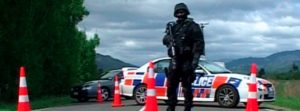Read the complete analysis of alleged Maori terrorism in the Urewera
Yeah right!
A blanket has been thrown over the process by which Cabinet authorised the anti-terrorism raids on 15th October 2007. This post and previous posts lift a corner of that blanket and the whole high level process doesn’t pass the smell test.
Although there is some visible evidence of the intelligence process at the working level (in affidavits, warrants, indictments and police evidence provided to the lawyers of the accused) there is no visibility or transparency above that. The intelligence process intimately involved the decision-makers from the analyst Detective Sergeant Pascoe’s immediate superior Detective Inspector Good, to Assistant Commissioner White, to Deputy Commissioner Pope, Commissioner Broad, to the Officials Committee for Domestic and External Security Coordination (ODESC), and to the Prime Minister and Cabinet.
We know that the SIS at least knew of the ongoing operation. We do not know if the SIS and GCSB were actively involved in Operation 8. It is reasonable to assume that the minister in charge of the SIS, Prime Minister Helen Clark, would have known in advance about the operation even if Annette King then Minister of Police, by her own testimony, did not know until the night before.
We know from public statements after the event that Commissioner Broad and the Prime Minister were both involved in the decision-making that launched the Operation 8 raids on 15th October 2007. What is not transparent is the advice presumably based on intelligence product that informed those decisions. What is also not transparent is the substance of those decisions.
Without that information there can be no full analysis of the professionalism and competence of the intelligence process. Operation 8 was not just a failure of intelligence at the working level but a failure of intelligence all the way up the chain of command and in the Cabinet itself. Intelligence failure at that high level level is not uncommon. Indeed in the world of Intelligence it is the most common level of failure.
This series has analysed in some detail the intelligence failure at the working level. The failures at the Police command level, at the senior officials and advisors level (ODESC) and at the political level remain hidden under the blanket; covered up.
The original intent of the investigators, presumably sanctioned and approved by the chain of command and Cabinet, was to prosecute under the Suppression of Terrorism Act. That was disallowed by the Solicitor General. Then the charges changed.
- What was it that the legal advisors, the chain of command, ODESC and Cabinet believed at the time that convinced them to mount a full scale anti-terrorism operation?
- Or was the use of the Suppression of Terrorism Act just an excuse to employ the wider surveillance powers allowed under that act?
- And were they all just hoping that the seizure of computers around the country would provide sufficient evidence to allow them to proceed and use evidence secured under the Suppression of Terrorism Act?
- If so, was the use of the Suppression of Terrorism Act to obtain the warrants and to mount a full scale anti-terrrorism operation totally unlawful like so much of the operation?
Given the lack of transparency of that higher level of decision-making it may only be discovered through a formal inquiry process by subpoena of witnesses, instructions and written orders, reports, assessments and minutes. And if that were to happen how might that evidence reflect on the outcome of the trial of the Urewera Four accused?
- What was the chain of command and what were they telling each other?
- Who did Detective Inspector Good and Detective Sergeant Pascoe report to? What did they report? Is there a written record of that report? Who reviewed and evaluated their analysis? Is there a written record of that review and evaluation?
- What were Detective Inspector Good’s and Detective Sergeant Pascoe’s orders from their immediate superior? Were they written orders? Or were they just freewheeling on their own without formal intelligence management oversight? The scapegoat question I fear.
- What was the complete chain of command from Detective Sergeant Pascoe to Commissioner Broad? What advice was given to Commissioner Broad and by whom? Is there a written record of that advice?
- Was legal advice sought and given prior to the October 15th armed paramilitary anti-terrorist operation? Who gave the advice? Was it the Solicitor General? Was it prosecutor Ross Burns? Was it written advice?
- Was Deputy Commissioner Pope involved in the decision to launch an anti-terrorism operation? What was his exact involvement?
- What advice if any did Commissioner Broad give to the Officials Committee for Domestic and External Security Coordination (ODESC)? Who was present at that meeting? Were the professional security and intelligence agencies present? Did they offer their professional assistance? Is it true that Commissioner Broad declined such assistance? Are there minutes of that meeting?
- What advice if any did ODESC give to Commissioner Broad? Is there a record of that advice? If not, why not?
- What advice if any did ODESC give to the Prime Minister and Cabinet? Is there a record of that advice? If not, why not?
- Did the NZ Police ever call upon the superior intelligence gathering and assessment skill and experience of the dedicated security and intelligence agencies? If not why not? Was SIS or GCSB involved?
- When did Commissioner Broad meet with the Prime Minister and Cabinet? Who was present at that meeting? What advice did he give to Cabinet? Was it written or verbal or both? Are there minutes of that meeting, including authorisation to proceed with a full-scale anti-terrorism operation?
- Is it true that Commissioner Broad was asked several times at that Cabinet meeting to confirm that there was a plot to overthrow government, and did he so confirm? We have this one public account only.
- What orders were given to the operational units that carried out the Operation 8 paramilitary operation? Were they written or verbal orders or both?
- What reports were submitted after the paramilitary operation? Are they written reports?
- Was the Solicitor General formally asked to authorise prosecution under the Suppression of Terrorism Act by written request? Did he write a formal rejection of the request stating his full reasons for that decision? Apart from those he publicly stated?
- Why were the contracts of Commissioner Broad and Deputy Commissioner Pope not renewed? Was it because new brooms were needed to bring in a new culture in the police, as was publicly stated? Or was it really because of incomptence and because they had misled Cabinet in seeking authorisation for the armed anti-terrorism paramilitary operation?
- Is the real reason for the non-renewal of their contracts part of a cover up?
The final questions are raised in the wake of the GCSB scandal and cover up legislation, and the revelations about the extent of the 5-Eyes global population level electronic surveillance.
- Was Operation 8 initiated as a result of GCSB eavesdropping on the nation’s communications?
- If so, was the police evidential trail manufactured in the process known in law enforcement as “parallel construction” to disguise the actual trail of evidence leading from GCSB? This would be another instance of unlawful behaviour by the police.
- Were GCSB and SIS involved in Operation 8 surveillance?
- Were GCSB and SIS involved in the analysis of information including data mining, traffic analysis and social network analysis?
- If GCSB was involved was it at the request of NZ Police and what was the lawful (or unlawful) basis of that request?
In a post on 23 October 2013 Jeremy Bioletti, the trial lawyer for Rangi Kemara, infers that these are very important questions:
“The issue of possible GCSB surveillance in operation 8 is important. Why? Because if there was illegality involved it may have tipped the balance in the Supreme Court and resulted in the exclusion of the evidence which allowed the Urewera Four to be put on trial and convicted for the firearms offences and subsequently imprisoned. I am certain that there was involvement because from memory there were personnel involved in the police operation which counsel were not allowed to ask questions about”.
The incompetence and ineptitude of the intelligence operation, and the evidential inconsistencies that would have been revealed by a much more thorough analysis of that process may also have tipped the balance in the Supreme Court and resulted in the exclusion of the evidence which allowed the Urewera Four to be put on trial and convicted and sentenced.
I am saying that none of the Operation 8 evidence should have survived beyond the Supreme Court hearing in May 2011, and the Supreme Court ruling a few months later in September, and that had justice been done the Urewera Four would not have gone to trial.
The only way to fully assess the Operation 8 intelligence management and analysis process is to discover all or most of the above information, through a formal inquiry. That formal inquiry is also required to discover which police officers breached their constables’ oath and broke the law in using unlawful means to acquire information, and which commissioned officers also breached the terms of their commissioning by the Queen of New Zealand. These are serious legal and ethical issues. The rule of law in a democratic society ought to apply equally to every citizen and the NZ Police must be seen to scrupuloulsy uphold the rule of law.
The only conclusion that can be drawn from the suppression of all that information and the refusal of both the Labour and National Parties to support an inquiry is that there is a cover up and that what is being covered up is political and bureaucratic incompetence and embarrassment, and a degree of illegality.
Smelly indeed.
Links: The Operation 8 Series


